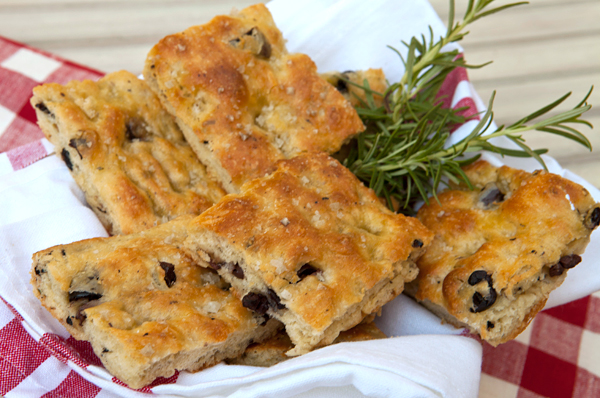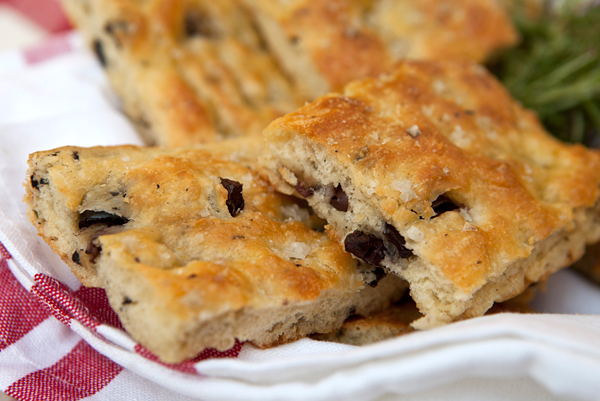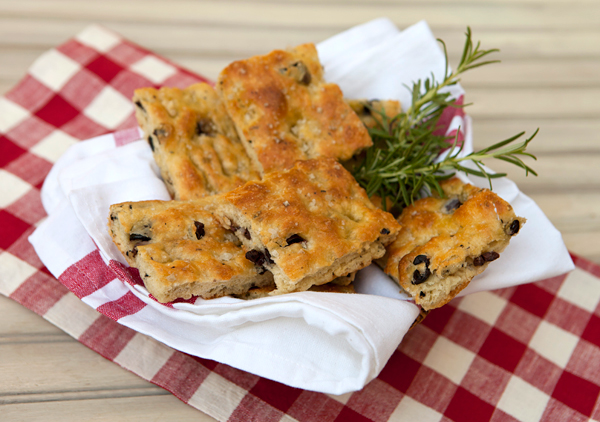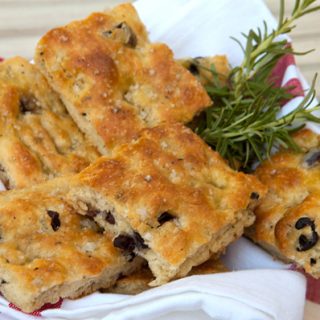Olive & Rosemary Focaccia

When we are in Umbria for our summer season, I generally bake a lovely big sheet of focaccia at least once a week, often sending over a plate of warm, crispy flatbread to our farmhouse guests. I just realized recently that I haven’t made focaccia for almost two months and like many things, once I had it in my mind, I just had to bake it.
I decided to add some tasty black olives into the dough as they are one of my favorite ingredients and always add a punch of flavor, and I added some chopped fresh rosemary as well. In Umbria, we have rosemary bushes growing wild around the two farmhouses that I can clip fresh sprigs from daily, but unfortunately, here in Florida my desire for fresh rosemary required a trip to two grocery stores before I could locate it. I was determined however, and I ended up buying a small pot of rosemary that should last me a couple of months.
One of the easiest breads for a novice baker to make is a simple focaccia. Focaccia dough lends itself to so many variations that once you master the dough, your options are endless. You can flavor the focaccia dough itself, add a myriad of different seasonal toppings both sweet and savory, create a crisp crusted focaccia that is perfect for dipping or spreading with creamy toppings, or make a thicker crusted focaccia that is perfect to use for sandwiches or panini.
Though I prefer my focaccia thicker, my husband likes it thinner with a crisper crust, so I baked this focaccia in a 17X11 inch baking pan. If you use a 13X9 inch pan, your focaccia will be thicker with a softer crumb. Do use really flavorful olives such as Kalamata or Gaeta, as the canned ones really won’t work. I’ve tried every combination of types of flour to make focaccia, and I’ve found basic all-purpose, unbleached flour works best.
It creates a flatbread with a soft crumb and crisp crust that lasts for a day or two. I often slice my focaccia into squares and freeze half for another day, and find the focaccia does freeze well.
The trick to making great focaccia is to ensure you create lots of dimples with your finger tips into your dough and then drizzle enough olive oil into those dimples which will then get absorbed while the focaccia bakes creating a flavorful bread with a crisp crust and tender interior.
To make a thicker dough, let the dough rise three times, and if you prefer a thin, crisp crust, let the dough rise just twice and bake immediately after you drizzle on your olive oil.


Buon Appetito!
Deborah Mele

Olive & Rosemary Focaccia
Ingredients
- 5 Cups All-purpose Unbleached Flour
- 2 Teaspoons Instant Yeast
- 2 – 3 Tablespoons Extra Virgin Olive Oil (Plus 2 Additional Tablespoons To Oil Bowl)
- 1 Teaspoon Salt
- 2 Cups Warm Water (Approximate)
- 1 1/2 Cups Pitted Kalamata Olives, Coarsely Chopped
- 1 Tablespoon Chopped Fresh Rosemary
For Baking:
- Extra Virgin Olive Oil
- Coarse Sea Salt
Instructions
- Measure and assemble your flour, oil, salt, yeast, and water.
- Add everything but the water into a large bowl and stir.
- Add half the water, olives and rosemary, and stir.
- Continue to add water until the dough begins to come together into a shaggy ball.
- Dump the dough mixture onto a lightly floured surface and begin to knead with the heels of your hand.
- Knead for about 5 minutes, or until the dough is smooth and pliant.
- Add a little oil (2 tablespoons) to the bottom of a large bowl and place your ball of dough inside.
- Roll the ball of dough around in the oil ensuring the sides of the bowl and ball of dough are both lightly oiled.
- Cover your bowl with plastic wrap and place in a warm spot to rise. (I cover mine with a kitchen towel on top of the plastic wrap and sit it on a large sunny windowsill.)
- Let the dough rise until it is doubled in size, about an hour or an hour and a half depending on ambient temperature.
- Lightly oil chosen baking sheet with sides.
- Dump your risen dough into the pan punching it down to deflate it.
- Use your fingers to push and press the dough evenly over the bottom of the pan.
- Cover with a kitchen towel and let rise for another 20 or 25 minutes or until the dough dimples when pushed with your fingertip.
- Use the tips of your fingers to dimple the entire top of the focaccia.
- Drizzle olive oil over the top turning the pan carefully to allow the oil to roll into the indentations.
- Sprinkle coarse sea salt over the top of your focaccia and then let it sit and rise for another 15 minutes while you preheat your oven to 425 degrees F.
- Bake for 20 to 25 minutes until golden brown, then cool to room temperature before slicing (if you can!).
I wondered if you have a particular way you like to freeze bread? I used to do it wrapped first in a layer of plastic wrap, then in foil, which always seemed to work very well; and now sometimes just use a Ziploc bag. But if you have a method that seems to work really well I’d be interested to hear. And when you defrost, do you remove entirely from the wrapping to avoid problems with extra moisture as it thaws? Thanks!
Terry, I simply use ziplock bags.
Deborah,
I am wondering if whole wheat flour could be substituted for the unbleached flour. What do you think?
You might ry white wheat flour, but whole wheat flour tends to be too dense on its own for focaccia.
I live in Central Florida and have great luck growing Rosemary!
just need to know if I can use normal self raising flour, please. thank you!
No, the recipe adds yeast, so self rising flour would entail using two rising agents. Regular plain flour is used.
We tried this recipe yesterday and I just have to say, it was absolutely wonderful! Thank you so much for sharing. (We shared your page because it was so wonderful we wanted our friends to try it too!)
I always use this site when looking for Italian dishes. Every single recipe results in a great meal, beyond delicious. The Focaccias’s recipes are a success for the family.
Thanks Martha!